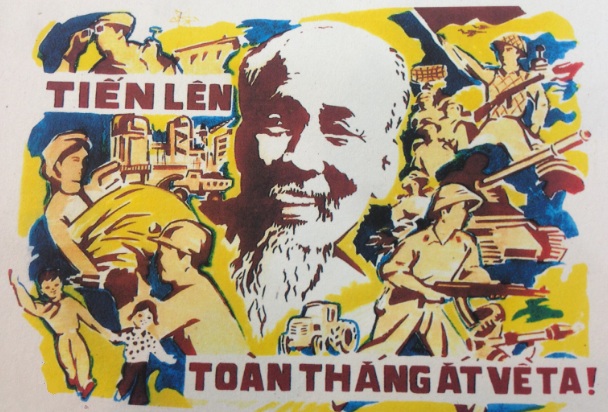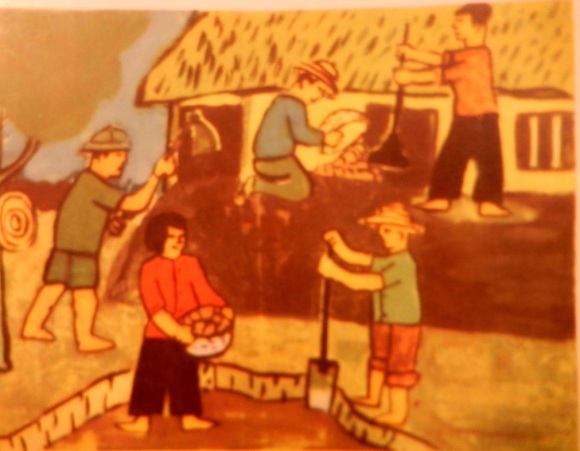|
|
NOTE: 'Life in North Vietnam' is required only by the iGCSE specification, and is not addressed in the recommended textbook. However, past iGCSE exams have asked questions about it.
|
Source A
"Go forward and victory will be ours!", by Thai Son, probably produced some time between 1969 and 1974.
|
Consider:Interpret Source A. What are its messages? How effective is it as a piece of propaganda?
|
Political Structure and Leadership• North Vietnam (officially the Democratic Republic of Vietnam, DRV) was a one-party state, led by the Communist Dang Lao Dong (Workers Party). • Ho Chi Minh, President 1945-69, was revered as the founding father of the nation. • Power was concentrated in the Politburo, and government was centrally planned; its key goal was to unify Vietnam under communism. • Under the 1959 Constitution, citizens had the duty to obey the law, pay taxes and defend the Fatherland. They were entitled to equality before law, the right to vote, equality between men and women, freedom of speech and belief, and to work, rest and study. • The Lao Dong Party was not large enough to staff a full civil service, so government at local level was administered by non-Communists, supervised by ‘cadres’ of Party officials. There were continual complaints about the inaccessibility of government to ordinary people. Repressive Measures• During a Land Reform campaign (1953–56), landlords and rich peasants were denounced; some were simply humiliated and impoverished, others were executed. • ‘Re-education’ in prison was used to suppress opposition; many died as a result of harsh prison conditions. The anti-communist writer Hoang Van Chi (who worked for the Diem government) claimed that more than half a million people died during the land reform and re-education campaigns of 1953-56. • A rebellion of 20,000 peasants in 1956 was crushed with 6,000 dead; in the 1967 ‘Anti-Party Affair’, hundreds of party cadres were arrested because they disagreed with the Politburo’s conduct of the war. • The Ministries of Culture and Communications controlled the press, radio, arts … and religion; although the Constitution promised freedom of belief, Catholics paid extra taxes, Catholic seminaries and publications were shut down, and Catholic missionaries were expelled. Economic Policies• After 1953, agricultural cooperatives were introduced, followed by full collectivization by 1960. • Although the Three-Year Plan (1958-60) fell short of its targets, rice production doubled, and electricity & coal production tripled. Mass mobilization campaigns, often using forced labour, built roads, irrigation canals and schools. • The number of factory workers quintupled 1955-60, but only 10% of the workforce worked in industry in 1960, and only 83,000 worked in ‘modern’ factories out of a workforce of 7.2 million – most worked in old and unsanitary premises. • A ‘patriotic emulation programme’ urged workers to exceed targets and ‘emulation fighters’ were rewarded. • There was a booming black market economy in alcohol, peanuts, salt, soap, seeds, fertilizer, sweet rice cakes, et al. which the government was unable to stop. Peasants in the collectives would skim off produce to sell illegally. |
Going DeeperThe following links will help you widen your knowledge: Narrative account from Alpha History Photos of Hanoi in the
1950s
YouTube FIlm clips of North Vietnam in the 1960s - the full 1967 film is here: Inside North Vietnam
Source BOfficial records from the time suggest that 172,008 "landlords" were executed during the "land reform".... Victims were reportedly shot, beheaded, and beaten to death; "some were tied up, thrown into open graves and covered with stones until they were crushed to death". The full death toll was even greater because victims' families starved to death under the "policy of isolation." As communist defector Le Xuan Giao explained: "There was nothing worse than the starvation of the children in a family whose parents were under the control of a land reform team. They isolated the house, and the people who lived there would starve."
Source CAs against the subjective "guesses" cited above, the statistics which have been publishd by the DRV, though admittedly incomplete ... suggests that from 800 to 2,500 executions during the land reform would be a realistic estimate. Evidence shows that, although the land reform program was marred by administrative failures, its aims were to liberate the poor peasants from the threat of famine and from their total subordination to the landlords. The benefits of the land reform to the poor peasants, who made up the majority of the rural population, were a substantial increase in rice consumption and an improved social and political status in the villages, Gareth Porter, The Myth of the Bloodbath (1972). |
Standard of Living• Desperately poor (see Source D), although attempts by the government to solve food shortages were beginning to work by 1960. The country relied on aid from China and the Soviet Union. Public Health & Social Infrastructure• In the 1950s, free medical services – communal health stations and field hospitals – were introduced, especially to rural areas. • Sanitation in rural areas was non-existent, and local ponds were used for drinking water, bathing and watering animals. The government ran campaigns such as “Clean food, clean habits, clean water” and “Destroy rats, destroy flies, destroy mosquitoes”. • In 1959 there were just 2,313 doctors and 10,000 nurses for a population of 16 million. Women’s Rights & Roles• Wome had gender equality, and legal rights in marriage, divorce, and property. • Women were regarded as key contributors to the revolution; they formed more than half the workforce, including serving in the armed forces during the war. • The Women's Union promoted female literacy and political engagement. • Women filled up to 25% of seats in the People’s Councils & Courts, and 11% of the National Assembly. Youth & Education• There was universal primary education – 1 million children aged 7-11 in 5,000 schools in 1959 (though only 15,000 in the 31 schools for 14-17 year-olds). The school curriculum taught Marxist ideology and nationalism, with frequent breaks for political meetings. Children of Party officials were taught in separate schools. • Adults were encouraged to attend education classes after work. • There was a University at Hanoi, but the standard of teaching was poor, so the cleverest students went to universities in the Soviet Union. In 1960, 1,000 apprentices were sent to China to train as technicians. • The Ho Chi Minh Young Pioneers Organization trained children in socialist values and revolutionary discipline. Youths were mobilized for labour projects. Work & Welfare• Until 1960, the Army provided much of the welfare , especially food and medicine • There was government food rationing and work-based healthcare. The Land Reform movement released 150,000 houses. • There were ideological drives against gambling, illegal distilling of wine, greediness & waste, and spending too much time in cafes. • A 1947 Labour Code prohibited child labour, limited hours of work and established a minimum wage. A decree of 1957 established benefits in case of injury or death. • The Tong Lien Doan (‘Total Union’) with half a million members was the only legal Union; its job was not to represent workers – it educated workers in socialist principles and supported the emulation campaigns. |
Source DFragmentary evidence suggests that the material conditions of life in North Vietnam in the late 1950s and early 1960s were poor – well below the general level in the South. The people lived frugally and knew much hardship. The urban worker got barely enough to eat, wore wooden clogs or went barefoot and spent most of his time working or attending meetings and study groups. In Hanoi electricity was reportedly turned off at 9 p.m., and although some Soviet trucks, government-owned automobiles, many bicycles and draft animals were seen on the streets, walking was the chief mode of transportation.. Dept. Army Foreign Areas Studies, US Army Area Handbook for Vietnam (1964).
Source EIn terms of food, we eat all kind of things. The factory has already been evacuated, so the canteen there isn’t active anymore. I just have to eat whatever I can scrounge up. Each meal cost about 20 cents, but it’s just plain rice. How can you swallow plain rice? Some days we had to work or attend meetings long after the end of our shift, so by the time we’re finished, there’s no food left. We have to go look elsewhere. These meals cost much more. I don’t want to eat at Uncle Huong’s house because the family and Auntie are already suffering from food shortages. Furthermore, the walk to his house is so far, so I try to keep my trips limited to the mornings and evenings. Letter from Nguyen Loi to his sweetheart (9 March 1967).
|
The War• The war destroyed most of what the government had been trying to achieve:
|
Source F
'Reinforcing the wall to protect our classrooms' – a painting by
school-pupil Phuong Quoc Thanh, 14 years old
(1969).
|
Source GIndustrial production and distribution have been seriously disrupted by United States retaliatory air attacks, which began early in 1965 after the regime’s intensification of the war in South Vietnam. By the end of 1966 the standard of living remained low, and increasing economic problems were indicated by the Premier’s announcement late in 1965 that a second Five-Year Plan would be abandoned, and production plans for 1966 and 1967 would be in accordance with a new policy under which the people would be called upon “to produce and fight at the same time.” Harvey Smith, Area Handbook for North Vietnam (1967).
|
Source HAt the Viet-Duc hospital in Hanoi, I watched an operation conducted by Dr Ton That Tung, a surgeon of worldwide fame. He told me ... the difficulties that were encountered. He said, laughing: "They destroyed everything, everything we built since 1954 is in ruins – hospitals, schools, factories, new houses. We don't have anything more to lose except independence and freedom. But to keep that, believe me, we are ready to endure everything." Account by French surgeon J-M Krivine of his trip to North Vietnam as part of a War Crimes investigation (1967).
|
Consider:1. The Army Area Handbooks and traditional accounts of North Vietnam under Ho Chi Minh present a country which is desperately poor and oppressed. The photos and film of the time show happy, healthy people and busy, thriving scenes. Have you any suggestions why? 2. Photos of South Vietnam in the 1960s show a country which is clearly more modern, more advanced and more prosperous than North Vietnam. Yet it was the South Vietnamese government which collapsed, and the North Vietnamese who kept going through thirty years of war and triumphed. Have you any suggestions why?
|
|
|
|
|
|
Spotted an error on this page? Broken link? Anything missing? Let me know. |
|

